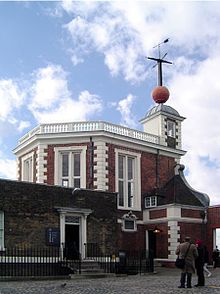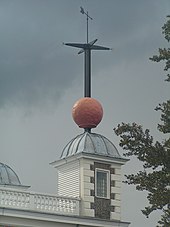Royal Greenwich Observatory
The Royal Greenwich Observatory ( RGO ; German Royal Observatory of Greenwich ), which was built as a workplace for the royal astronomers , was originally located on a hill in Greenwich Park in Greenwich , London , from where the Thames can be seen. The observatory , more precisely the center of the telescope in the observatory, was used as a reference for determining the prime meridian (meridian of Greenwich) and thus the degrees of longitude , as well as Greenwich Mean Time (mean local time on the Greenwich meridian). It is marked in the courtyard by a brass strip. Since December 16, 1999, the line has been illuminated by a powerful green laser that shines north through London and Essex at night.
The observatory was founded on June 22nd, 1675 by King Charles II of England and its construction was commissioned by John Flamsteed . The Flamsteed House (1675–76), the original part of the observatory, was designed by Sir Christopher Wren and built on the foundations of a castle. It is the second oldest of its kind in Europe after the observatory in Paris.
In 1948 the Royal Greenwich Observatory moved to Herstmonceux , near Hailsham in East Sussex , for clearer nights of observation. The Isaac Newton Telescope was built there in 1967 but was moved to the Roque-de-los-Muchachos Observatory on La Palma , Spain in 1979 . In 1990 the Royal Greenwich Observatory moved again, this time to Cambridge . It was closed in 1998 following a decision by the Particle Physics and Astronomy Research Council . The HM Nautical Almanac Office was relocated to the Rutherford Appleton Laboratory after it was closed . Other research was brought to the UK Astronomy Technology Center in Edinburgh .
Since 1995 the International Study Center of Queen's University , Kingston, Canada and the Observatory Science Center have been located in Herstmonceux Castle.
Greenwich Mean Time
The Greenwich Mean Time (GMT), was once the time measured in Greenwich at the observatory before the Coordinated Universal Time was replaced (UTC). Although there is no longer an active astronomical observatory in Greenwich, it remains a center of modern astronomy .
The time ball
The leather-covered time sphere was installed on the roof of the observatory by court astronomer John Pond in 1833 . This is still pulled up every day and falls down at precisely 1 p.m. (2 p.m. CET ; in summer at 1 p.m. summer time , 2 p.m. CEST). This enabled the ships on the Thames to set their ship chronometers to the exact Greenwich Mean Time. On December 6, 1855, the time ball was torn off in a storm. In 1919 the leather time ball was replaced by today's red ball made of aluminum.
museum
Today there is a museum for astronomy and navigation tools in the observatory . Furthermore, the development of time measurement from the Middle Ages to the modern age is discussed. The exhibition shows the connection between time measurement and global positioning using the sun and stars. A special exhibit is the first replica of the length chronometer H1 by John Harrison (the originals H1 to H4 are on display in the neighboring National Maritime Museum ). A visit to the private apartment of the astronomer John Flamsteed is also possible. The Shepherd Gate Clock is built into the right gate pillar of the entrance portal .
Museum Hill offers views of London, particularly Docklands , Canary Wharf's skyscrapers and the Millennium Dome . It is also possible to climb the observatory tower.
history
- 1675 Royal Observatory is built on the site of the former Greenwich Castle .
- October 13, 1884 At the International Meridian Conference in Washington DC, the Meridian is the Royal Observatory in Greenwich as the prime meridian set
- 1948 Royal Observatory moves to Herstmonceux , becoming the Royal Greenwich Observatory (RGO). The Greenwich square becomes the Old Royal Observatory.
- 1990 RGO moves to Cambridge. The SLR facility remains in Herstmonceux.
- 1998 RGO is closed. The Greenwich Square becomes the Royal Observatory, Greenwich, and is part of the National Maritime Museum .
The main inner belt asteroid (2830) Greenwich is named after the observatory.
Position to today's prime meridian
The global coordinate systems in use today are defined by many fundamental stations instead of just one (see ITRF ). The reference meridian of these systems, e.g. B. also that of the WGS 84 , runs about 102 meters east of the prime meridian established by the International Meridian Conference in 1884 past the observatory. The main reason for the difference is the deviation from the perpendicular in Greenwich.
literature
- E. Walter Maunder: The Royal Observatory, Greenwich: A Glance at its History and Work. The Religious Tract Society, London 1900.
- RO Meibauer: The Greenwich Observatory. Berlin 1868.
- D. Howse: Greenwich Observatory: Buildings and Instruments. London 1975.
- PS Laurie: The buildings and old instruments of the Royal Observatory, Greenwich. In: The Observatory. Vol. 80, 1960, pp. 13-22.
- GB Airy: Plan of the Buildings and Grounds of the Royal Observatory, Greenwich, 1863, August; with Explanation and History. In: Greenwich Observations in Astronomy, Magnetism and Meteorology made at the Royal Observatory. Series 2, vol. 24, p. F1-FPIV.
- Derek Howse: Greenwich Time and the Longitude. Official Millennium ed. Philip Wilson, National Maritime Museum, London 1997, ISBN 0-85667-468-0 .
Web links
- THE STORY OF THE ROYAL GREENWICH OBSERVATORY AT HERSTMONCEUX
- HM Nautical Almanac Office
- The Royal Observatory, Greenwich
- Telescopes at the Royal Observatory Greenwich
- The National Maritime Museum , The Longitude of Greenwich
- The Observatory Science Center
- Isaac Newton Group of Telescopes
- STFC Rutherford Appleton Laboratory
- The History of the Nautical Almanac & HM Nautical Almanac Office
- Institute of Astronomy, University of Cambridge UK
Individual evidence
- ^ The Greenwich Time Ball and one time for all. August 24, 2015, accessed July 28, 2016 .
- ^ Lutz D. Schmadel : Dictionary of Minor Planet Names . Fifth Revised and Enlarged Edition. Ed .: Lutz D. Schmadel. 5th edition. Springer Verlag , Berlin , Heidelberg 2003, ISBN 978-3-540-29925-7 , pp. 186 (English, 992 pp., Link.springer.com [ONLINE; accessed on September 16, 2019] Original title: Dictionary of Minor Planet Names . First edition: Springer Verlag, Berlin, Heidelberg 1992): “1980 GA. Discovered 1980 Apr. 14 by E. Bowell at Anderson Mesa. "
- ^ Stephen Malys et al .: Why the Greenwich meridian moved . In: Journal of Geodesy . tape 89 , 2015, p. 1263-1272 , doi : 10.1007 / s00190-015-0844-y (English).
Coordinates: 51 ° 28 ′ 40 ″ N , 0 ° 0 ′ 5 ″ W.




